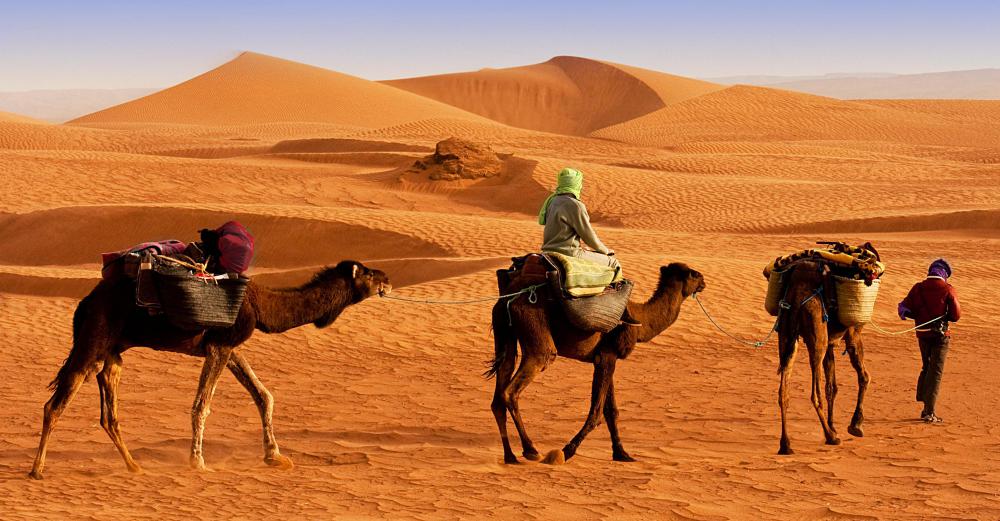What is a Sandstorm?
 Tricia Christensen
Tricia Christensen
A sandstorm refers to a high amount of wind occurring in sandy areas, usually in deserts, where the wind speed is able to lift the top layer of sand from the ground, and push it in every imaginable direction. The sand involved in the sandstorm can reach heights of approximately 10-50 feet (3.05-15.24m). Usually, the height of a sandstorm corresponds to wind strength. Dust particles associated with some sandstorms have been found at 5000 feet (1524 m), though these are more rare.
It is very dangerous to navigate through a sandstorm, since your ability to see ahead can be severely obstructed. Additionally, sand can get into the nose, eyes, mouth and lungs. If you happen to be caught in a sandstorm protective eyewear like goggles, and wearing a moistened scarf over the nose and mouth are highly recommended.

Anyone who’s ever played or walked on sand can attest to how easily sand slips into clothing, shoes, and hair. In a sandstorm, sand can get into machinery, causing it to fail. If you’re driving when such a storm approaches, it’s recommended that you pull off the road, since you may not have enough visibility to continue driving. This is also important since vehicles can fail in during sandstorms and you could end up stuck on the road. Anyone else driving might not be able to see your vehicle, creating a recipe for disaster.

Most sandstorms occur in spring, and during the daytime. They tend to be milder in the US than they are in other parts of the world. Much of the area around the Persian Gulf and the Sahara Desert is associated with the most potentially devastating storms. Since they’re a natural phenomenon, they can’t be entirely controlled. Yet, certain things in less typically arid regions may slightly reduce the chances of this type of storm occurring. For instance, the Dustbowl, a series of dust/sandstorms, which occurred in Midwest America and Southern Canada during the 1930s, was largely due to overworking of the land, drought, and inadequate watering of crops.

In areas that are naturally desert territory, you can’t always prevent a sandstorm. There’s much evidence that the planet Mars has dust storms, and clearly, no human intervention is responsible for such. Though it can move whole sand dunes, destroy crops, and cause chaos, a sandstorm is not without benefit. The redeposition of sand and dust to other regions may provide environmental benefits, like enriching soil in rain soaked areas.
AS FEATURED ON:
AS FEATURED ON:
















Discussion Comments
It is very dangerous to navigate through a sandstorm, since your ability to see ahead can be severely obstructed. Additionally, sand can get into the nose, eyes, mouth and lungs. If you happen to be caught in a sandstorm protective eyewear like goggles, and wearing a moistened scarf over the nose and mouth are highly recommended.
It's very frightening to be caught up in such a massive storm. You can't go outside or open your windows unless you want a house full of sand.
Right after the storm passed I had an inch of dirt in the bottom of my pool. My roof, lawn, driveway, everything outside was covered in dust.
Even my vehicle which was parked inside the garage had a light coating of dust on it. It's impossible to escape the mess and destruction these storms leave behind.
The one in Arizona started out in Tucson but radar data actually reported heights of eight to ten thousand feet by the time it reached Phoenix.
I've lived here in the valley for almost twenty-five years. Dust storms are very common here especially when we're under a season of drought.
I have to admit though that out of all the years I've lived here, I have never in my life experienced anything like the July 2011 sandstorm. It was amazing and frightening all at the same time.
Did anyone hear about that massive sand storm that whipped through Phoenix, Arizona in early July 2011?
I have family who came to visit us in Texas and had just driven through Phoenix from California that day before the storm hit.
I was told it was fifty miles wide and had reached a height of five thousand feet. The entire city was covered in a blanket of sand the next day.
Luckily my relatives started their journey a day earlier than they'd planned otherwise they might never have made it.
Post your comments